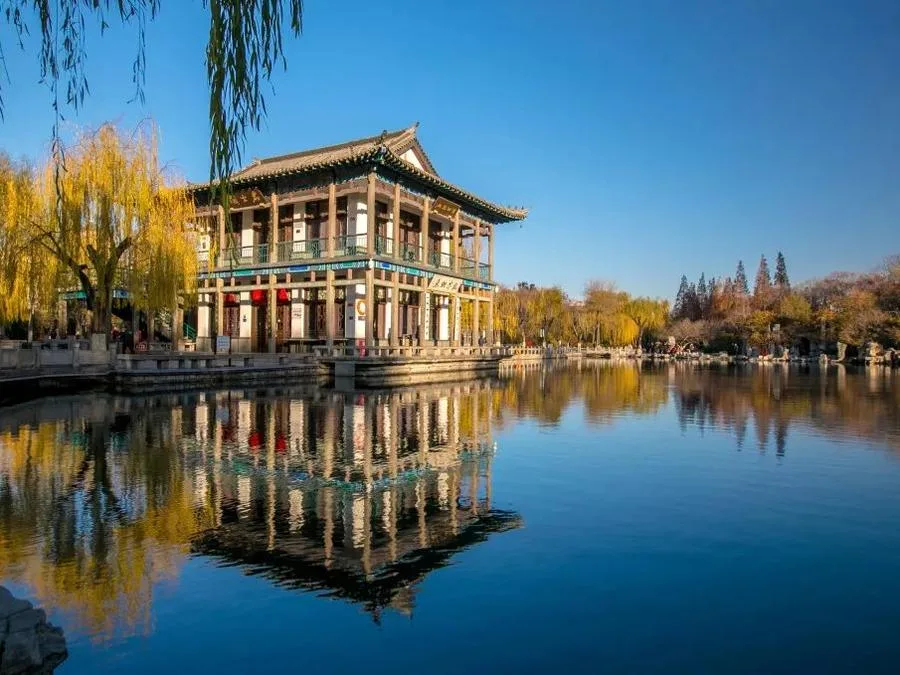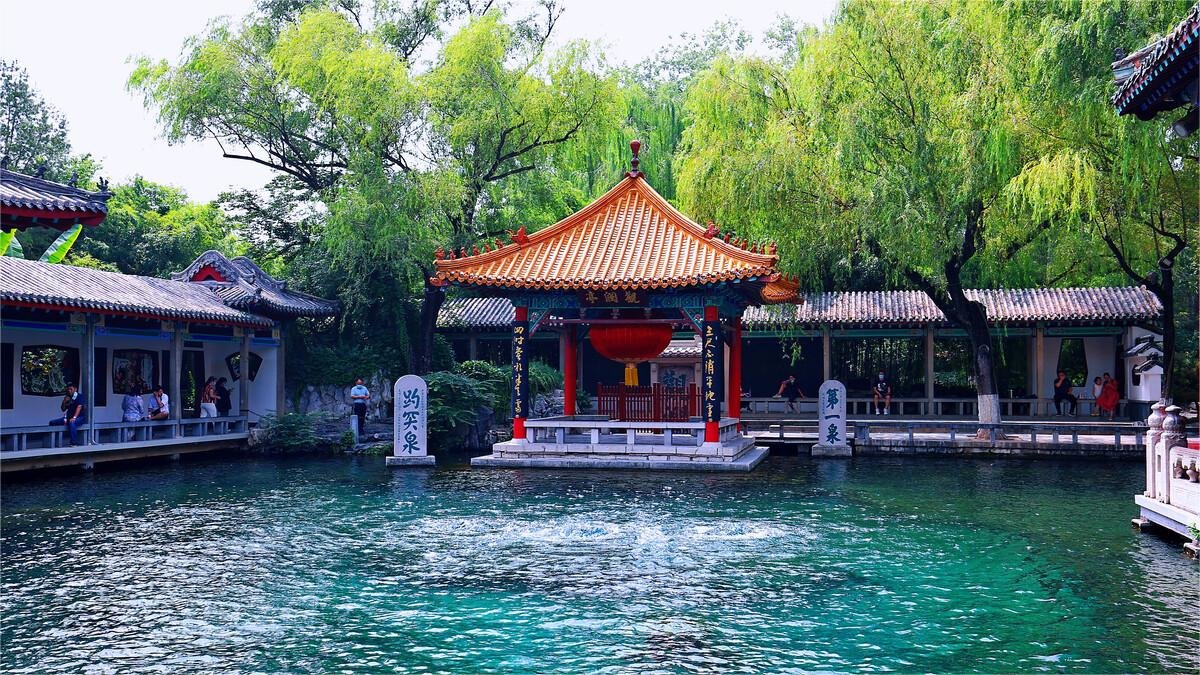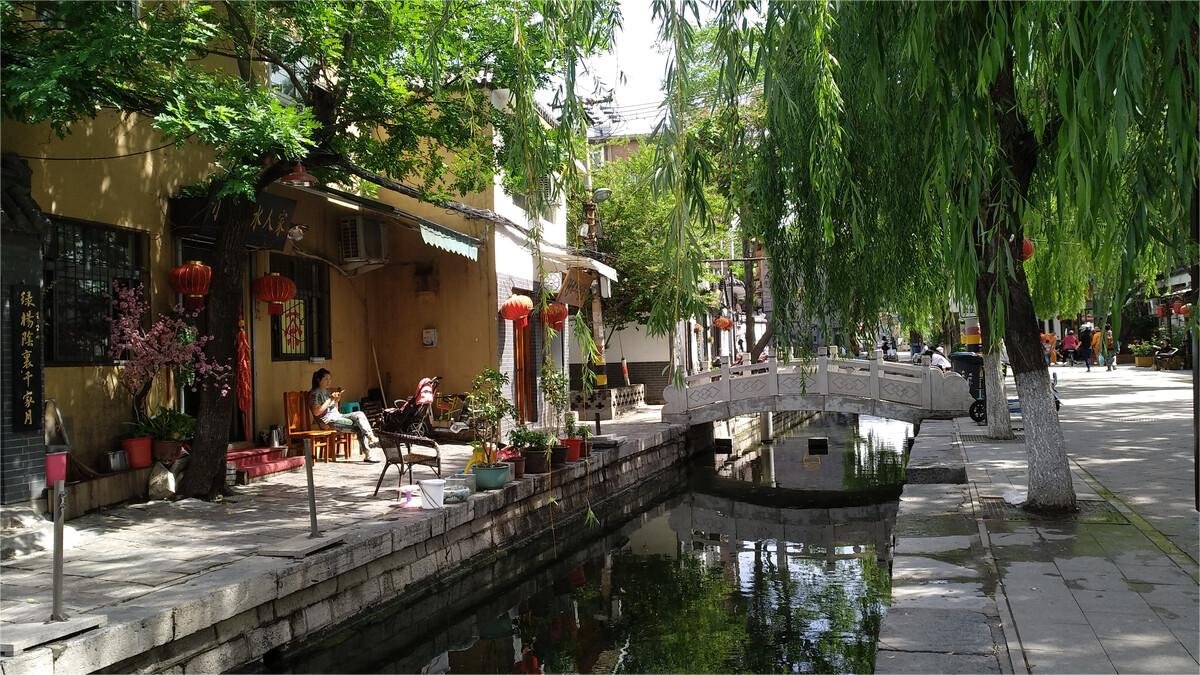Baotu Spring (趵突泉, Baotuquan), located in the bustling center of Jinan, is one of the city’s three major attractions along with Thousand Buddha Mountain and Daming Lake. Spanning an area of 158 acres, Baotu Spring is the most renowned among Jinan’s 72 famous springs. During the Qianlong Emperor’s southern tours, he praised the spring’s water for its purity and sweetness when used to make tea, bestowing upon it the title of “the best spring under heaven.” It is also the earliest Jinan spring mentioned in ancient literature.
The spring’s main source is situated in front of Luoyuan Hall within Baotu Spring Park. In 1931, the surrounding area was reinforced with stone embankments, forming a rectangular pool that measures 30 meters in length, 18 meters in width, and 2.2 meters in depth. The pool is bordered by Luoyuan Hall to the north, Guanlan Pavilion to the west, Laicui Bridge to the east, and a long corridor to the south. The spring water flows from an underground limestone cave, producing about 70,000 cubic meters of water daily from three main outlets, with a maximum discharge of 162,000 cubic meters per day. The water maintains a constant temperature of around 18°C (64°F) throughout the year.
Surrounding Baotu Spring are over 30 other notable springs, including Jinxi Spring, Shuyu Spring, Xibo Spring, Liuxu Spring, Huanghua Spring, Dukang Spring, and Bailong Spring, forming the Baotu Spring cluster. This group of springs collectively enhances the charm and significance of Baotu Spring Park, making it a must-visit destination for visitors to Jinan.
Table of Contents
- Basic Information
- Location and Transportation
- Map of Baotu Spring
- Highlights of Baotu Spring
- Origin of Baotu Spring’s Name
- Vlog about Baotu Spring Park
- Other Attractions in Jinan Downtown
Basic Information
| Estimated Length of Tour | 1 – 2 hours |
| Ticket Price | 40 RMB |
| Opening Hours | 7.00 – 19.00; Last admission: 18.30 |
| Area | 105333 square meters |
| Highlights | Guanlan Pavilion, Luoyuan Hall |
| Telephone Number | 0086-0531-86920900 |
Location and Transportation
Baotu Spring is located at No. 1 Baotuquan South Road, Lixia District, Jinan City, Shandong Province. It lies east of Quancheng Square and overlooks the Wu Long Tan to the north. To get there, you can take bus B100, B103, B165, B52, K102, K128, K28, K49, K54, K72, K82, or K96 and get off at Baotu Spring South Gate Stop (趵突泉南门站).
Map of Baotu Spring

Highlights of Baotu Spring
Various Inscriptions

The south gate of Baotu Spring features a horizontal plaque with the inscription “趵突泉 (Baotu Spring)” in gold characters on a blue background. This calligraphy is the work of the Qianlong Emperor of the Qing Dynasty, and it has been hailed as the “First Gate” of Chinese gardens.
Guanyuan Pavilion, constructed in the fifth year of the Ming Dynasty’s Tianshun reign (1461), was built by two eunuchs, Wei and Wu, who were imperial envoys to Jinan. Another account attributes its construction to the governor Hu Zongzong. The pavilion’s name, “Guanyuan,” is derived from a passage in Mencius’ “Jinxin I,” meaning “the art of observing water lies in observing its waves.” Originally, this pavilion was a semi-enclosed structure with open sides. The renowned Song Dynasty writer Su Zhe, who served as a secretary in Qizhou in 1073, composed numerous poems about Jinan’s scenic spots, with his poem about “Jian Spring Pavilion” being particularly famous.

In front of Guanyuan Pavilion, a stone tablet stands in the water inscribed with the characters for “趵突泉 (Baotu Spring),” written by the Ming Dynasty calligrapher Hu Zongzong. To the east of the pool is the “Laihe Bridge,” and at the southern end of this bridge is a wooden archway. The horizontal plaque on this archway bears the inscriptions “洞天福地 (Blessed Land of Celestial Paradise)” and “蓬山旧迹 (Remnant Site of Penglai),” enhancing the mystical aura of the location.
Additionally, a stone tablet beside Baotu Spring is inscribed with “第一泉 (The First Spring)” in dark green characters. This inscription dates back to the Tongzhi period of the Qing Dynasty (1861-1874) and was penned by Wang Zhonglin, the governor of Licheng. These various inscriptions, each with their unique historical and artistic value, contribute significantly to the allure and prestige of Baotu Spring.
Historic Bridges

Guanlan Bridge is located to the west of Baotu Spring, between Eying Temple and Tongluo Garden. The bridge, which is 3 meters wide and 5 meters long, has a graceful arch design and is constructed in a traditional style with an east-west orientation. It is named Guanlan Bridge because it offers a perfect vantage point to view the waters of Baotu Spring.
Guanghui Bridge is situated approximately 30 meters north of Guanlan Bridge. This bridge is documented in historical texts such as Ming Dynasty’s “Licheng Records” by Liu Chi and the “Chronicles of Licheng County” from the Chongzhen era. The south wall of the bridge features a stele from the fourth year of the Tongzhi era, detailing the bridge’s renovation. The inscription mentions: “Jinan, also known as Dabanchiao, is several thousand meters south of Baotu Spring. The springs of the Qing Mountains merge with the northern waters here. During the summer and autumn, the mountain waters surge and rush turbulently.”

Laihe Bridge originally was a wooden structure, oriented north-south, on the eastern bank of Baotu Spring Pool, southwest of Wanghe Pavilion. It was first built by Zhang Heming, the governor of Licheng during the Wanli era of the Ming Dynasty, and later renovated by Fan Shiying, the governor of Jinan during the Tianqi era. Another renovation was conducted by the imperial inspector Cheng Gong during the Shunzhi era of the Qing Dynasty. Initially, the bridge was made of wood, but it was later replaced with flat stone slabs. During the expansion of Baotu Spring Park in 1964, the stone slabs were updated, and in 1975, carved stone railings were added to both sides of the bridge.
Guishi (Turtle Stone)

The Guishi is a notable remnant from the Yuan dynasty, originally part of the villa “Yunzhuang” owned by the renowned Yuan-era poet Zhang Yanghao. Historical records indicate that Yunzhuang contained ten exquisite stones, known as the “Ten Friends,” with the dragon, phoenix, turtle, and qilin stones being particularly famous. Over time, these stones were relocated to various significant sites in Jinan, including Huangting, the Confucius Temple, and Baotu Spring.
The Turtle Stone is the only surviving piece of the four legendary stones, as the Qilin Stone was destroyed during the Second Sino-Japanese War by a bombing raid. The Turtle Stone is a striking Taihu stone, known for its delicate and lifelike appearance. Standing nearly 4 meters tall and weighing approximately 8 tons, it is characterized by its slender, porous structure with prominent veins and numerous cavities. These features embody the distinct qualities of Taihu stones: “wrinkled, thin, perforated, and transparent.”
Luoyuan Hall

Luoyuan Hall is located on the northern bank of Baotu Spring. Originally, this site was home to Ejiang Temple, dedicated to the two daughters of Emperor Yao, Ehuang and Nüying, who were the wives of the legendary Emperor Shun. The complex consisted of three main buildings, forming a significant architectural ensemble.
During the Jin and Yuan dynasties, the temple transitioned into a Taoist shrine dedicated to Lü Dongbin, a deity who gained popularity during the Song dynasty. Renowned literary figure Zeng Gong served as the governor of Qizhou during the Northern Song dynasty (1072-1073) and constructed two pavilions by the Luoshui River. The southern pavilion, situated by the river’s source, was named “Luoyuan Hall,” while the northern pavilion, facing Lishan, was called “Lishan Hall.” Later, Jin dynasty poet Yuan Haowen transformed these pavilions into a temple dedicated to Lü Dongbin.
In the Ming dynasty, officials Zhang Kuiguang, Fan Shiying, and Lü Huangzhong converted the temple back into a pavilion. Eventually, the original name “Luoyuan Hall” was restored, honoring the site’s historical roots.
Baixue Tower (Snow Tower)

Baixue Tower, situated to the southeast of Baotu Spring, was originally built to honor the Ming dynasty literary figure Li Panlong. In his later years, Li Panlong constructed a tower named Baixue Tower by Baihua Pond at Daming Lake. Inspired by his legacy, Ye Mengxiong, the Right Vice Minister of Shandong during the Ming Wanli period (1572-1620), funded the construction of a third Baixue Tower near Baotu Spring. Unfortunately, the tower fell into disrepair and was demolished during the expansion of Baotu Spring Park in 1956. It was rebuilt in 1996, restoring a significant cultural monument to the area.
Festivals and Events

Baotu Spring is also famous for its vibrant festivals, which showcase the local culture and traditions.
Baotu Spring Lantern Festival: This long-standing tradition takes place annually from the first day of the Lunar New Year and lasts for a month. The festival is a major cultural event in Jinan, often described with the phrase, “The New Year isn’t complete without viewing the lanterns at Baotu Spring.” The festival features a stunning display of lanterns, creating a festive atmosphere that attracts both locals and tourists.
Spring Water Culture Festival: Held in late September when the springs are at their most vigorous, this festival celebrates the rich water culture of Jinan. Lasting about ten days, the event includes various activities such as opera performances, folk activities, art exhibitions, and acrobatics. These festivities highlight the cultural and historical significance of the springs, providing a lively and engaging experience for visitors.
Origin of Baotu Spring’s Name
Baotu Spring, originally without an official name, is historically linked to the ancient Luoshui River, often referred to as “Luo” in historical texts. The Northern Wei geographer Li Daoyuan mentioned it in his “Commentary on the Water Classic” (Shui Jing Zhu), describing it as: “The Luoshui River originates southwest of the old city of Licheng County, where the spring water surges upwards like a wheel.” Due to the presence of the Ehuang and Nuying Temple built for worshiping the legendary figures Ehuang and Nuying, the spring was also commonly known as “Eying Water.”
In the Song Dynasty, Zeng Gong, who served as the governor of Qizhou, named the spring “Jian Spring.” The term “Jian” was a borrowed word, meaning overflow. However, the locals of Jinan found the name too refined and did not adopt it. The Jin Dynasty scholar Yuan Haowen recorded in his “Travel Notes in Jinan” that: “In recent times, a governor renamed the spring Jian Spring and even erected a Jian Spring Archway, drawing upon poetic meaning. Yet, the locals continued to call it Baoliu Spring.” The name “Baoliu,” meaning “bursting flow,” persisted among the locals, and it led to various similar names, including “Baotu.”
Zeng Gong documented in his “Records of the Two Halls of Qizhou” that: “From the (Kema) Cliff northwards to the west of Licheng, a distance of about fifty li, there are springs gushing forth, some rising several feet high, and the nearby people call it Baotu Spring.” The term “Baotu” means leaping and rushing, capturing the dynamic and vigorous nature of the spring’s flow. This vibrant and picturesque description aptly characterizes the energetic and lively essence of Baotu Spring, cementing its name in the local vernacular and historical records.








The scenery at Baotu Spring Park is beautiful; every snapshot turns out great. It’s perfect for a leisurely stroll to enjoy the flowers, plants, and fish.
I thought there would be no one at the Baotu Spring at 8 AM, but instead, it was packed with people.
The various plum blossoms at Baotu Spring are incredibly beautiful!
During the Spring Festival, the Baotu Spring Park was more crowded than the koi fish pool. It was a cloudy day, but the spring water was still very clear! The water from the Three-Eyed Spring was clearly visible!
The afternoon sunlight is just perfect, so I took a stroll around Baotu Spring. The park is all lit up with lanterns, and they officially turn on the lights on January 20th. It feels great!
Although it’s winter, there is sunshine every day in Jinan. The fish in the spring water pool are incredibly plump – they’re all chubby babies!
It’s that time of year again for the chrysanthemum viewing. The chrysanthemum exhibition at Baotu Spring is right on schedule. Listening to the spring water, admiring the flowers, and seeking out autumn… it was simply delightful!
I didn’t expect the water at Baotu Spring to be so clear and beautiful. I arrived around five in the afternoon, and there was hardly any sunlight left. After strolling for an hour, it became dark. Although the park closes at seven, it was difficult to take photos in the dark, so it’s better to arrive a bit earlier.
I thought there would be fewer people towards the end of summer vacation, but it was still very crowded. The spring water is genuinely refreshing, but there are indeed a lot of people.